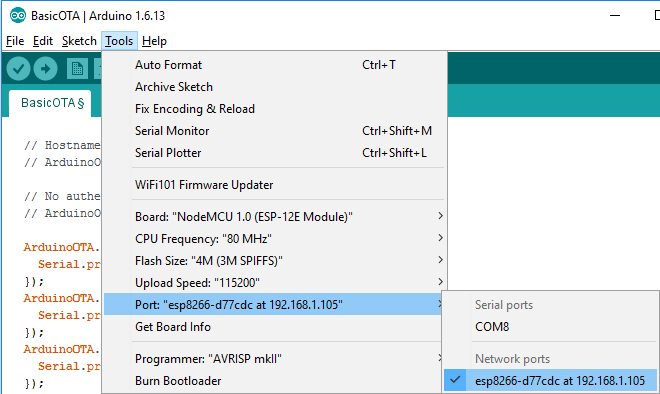
- #Esp8266 firmware for arduino install#
- #Esp8266 firmware for arduino update#
- #Esp8266 firmware for arduino driver#
- #Esp8266 firmware for arduino full#
- #Esp8266 firmware for arduino portable#
#Esp8266 firmware for arduino driver#
You can also try downloading the ready-to-go package from the ESP8266-Arduino project, if the proxy is giving you problemsĢ.Install the COM/Serial port driver for USB. In its bottom right corner you will see something about download program function button.ġ.Install the Arduino IDE 1.6.4 or greaterĭownload Arduino IDE from (1.6.4 or greater) - don't use 1.6.2! You can use your existing IDE if you have already installed it.(We're seeing some difficulties with IDE 1.6.6 so please try 1.6.5 or skip 1.6.6!) Input command statement into the below edit box.Īlso you use some of the function of the display on the right of the NodeMCU Lua.Ģ.you can check the information about the chip and restart NodeMcu.like as bellow:ģ.Connect the wireless networks around you Then connect the USB cable with it, and click the "Connect" button on the top of menu. Now do a demonstration with the LuaLoader.įirst, disconnected the usb cable and run the LuaLoader Ĭlick the menu "Setting", choose the"Comm Port Settings", and it'll popup a "Serial Advanced Setting", you could set the port there. Next up, we need to choose a development tool such as LuaLoader/ NodeMCUStudioIDE/ Decoda. When the firmware is flashing the blue led in the ESP8266 IOT Board will continuous flashing. Note:The COM Port you should choose what are you using.Ģ.Download the firmware and click the config button,then load the firmware.ģ.Then click the "Flash" button to load the firmware,as bellow: Our ESP8266 IOT Board had comes preprogrammed with the Lua interpretter.You can direct use it.ġ.Download the tool nodemcu-flasher-master,unzip it and choose the right loading software according to your computer system(32 bit or 64 bit) ,open it you can see as bellow: If you want to burning the firmware,please refer the following steps.
#Esp8266 firmware for arduino install#
In order to upload code to the ESP8266 and use the serial console, connect any data-capable micro USB cable to the IOT board and the other side to your computer's USB port.Maybe you need to install the cp2102 USB driver,you can download driver hear.

The Lua interpretter runs on the ESP8266 and you can type in commands and read out the results over serial. It's easy to power it both when connected to a computer as well as lipo batteryĮSP8266 IOT board comes pre-programmed with NodeMCU's lua interpretter. Usage Hardware installation 1.Power Management
#Esp8266 firmware for arduino update#
Micro USB port - it use for upload the program and update firmware,you can also charge the batteryīattery interface - you can power this board with a lipo battery by this portįlash button - it use for update the firmware Pin #2 blue LED for bootloading debug & general purpose blinking

Pin #0 red LED for general purpose blinking.Built in 100mA LiPoly charger with charging status indicator LED, can also cut a trace to disable the charger.9 x GPIO pins - can also be used as I2C and SPI.Auto-reset support for getting into bootload mode before firmware upload.CP2012 USB-Serial converter onboard with 921600 max baudrate for uploading.3.3V regulator with 500mA peak current output.Lipoly battery and USB cable not included (but we do have lots of options in the shop if you'd like!) (It comes preprogrammed with the Lua interpretter) We also toss in some header so you can solder it in and plug into a solderless breadboard. Comes fully assembled and tested, with a USB interface that lets you quickly use it with the Arduino IDE or NodeMCU Lua. The board will automatically switch over to USB power when its available. But, if you do have a battery, you can take it on the go, then plug in the USB to recharge.

You don't need a battery, it will run just fine straight from the micro USB connector.
#Esp8266 firmware for arduino portable#
To make it easy to use for portable projects, we added a connector for 3.7V Lithium polymer batteries and built in battery charging. It also has auto-reset so no noodling with pins and reset button pressings. We wired up a USB-Serial chip that can upload code. You can program the microcontroller using the Arduino IDE for an easy-to-run Internet of Things core.
#Esp8266 firmware for arduino full#
This microcontroller contains a Tensilica chip core as well as a full WiFi stack. It’s an ESP8266 WiFi module with all the extras you need, The most important part is an ESP8266 WiFi microcontroller clocked at 80 MHz and at 3.3V logic. This is a ESP8266 IOT board- our take on an 'all-in-one' ESP8266 WiFi development board with built in USB and battery charging.


 0 kommentar(er)
0 kommentar(er)
